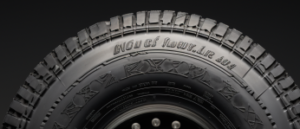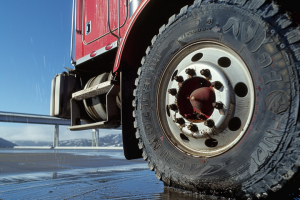Last Updated on April 25, 2024
Understanding the Trade-Offs of Using Second-Hand Truck Tires
In commercial transportation and logistics, truck tires are essential in ensuring safety, efficiency, and cost-effectiveness. Due to the rising cost of new tires and the increased awareness of sustainability measures, used truck tires are becoming a popular substitute in the market. This introduction details the subtleties of used truck tires, which also sets the stage for thoroughly examining their advantages and disadvantages.
Overview of Second-Hand Truck Tires
Used or pre-owned tires, often known as second-hand truck tires, have been driven on another car. These tires come from various sources, such as upgrading fleets or trucks that have been decommissioned and replaced before they reach the end of their useful life for performance-related reasons. Used tires are offered after a certain amount of wear and usage, significantly impacting their price point compared to new tires.
Several alternatives are available regarding size, tread pattern, and wear level of used truck tires. These tires are available through commercial trucking service providers, internet marketplaces, and specialty tire stores. The primary factor that draws people to used tires is their affordability; as such, truck owners and small-scale logistics companies often opt for them.
However, the condition and history of these tires vary significantly. Some second-hand tires are nearly new, having been used for only a short period, while others may be approaching the end of their usable life. The variability in condition necessitates a thorough understanding of tire evaluation metrics, such as tread depth, sidewall integrity, and overall tire health.
Maximizing Value and Safety
This blog article aims to inform truck operators and owners about the nuances of used truck tires. It includes understanding the trade-offs between cost and safety, evaluating the tires’ quality and suitability for various trucking applications, and negotiating the legal and compliance issues surrounding their use.
Additionally, this post offers a balanced perspective, highlighting the advantages and potential risks of using second-hand tires. By doing so, it seeks to equip readers with the knowledge required to make informed decisions that align with their operational requirements and budget constraints.
Understanding Second-Hand Truck Tires
Understanding Second-Hand Tires” delves into the trucking industry’s intricate world of used tires. This segment explores the various types of second-hand tires available, their origins, and their implications for truck performance and safety. It aims to give truck owners and operators essential insights into these tires’ nuances, helping them confidently navigate the complex market. From evaluating tire quality to understanding the balance between cost efficiency and safety, this introduction sets the stage for an informed journey into making the right tire choices for your trucking needs.
Definition and Types of Second-Hand Truck Tires
In trucking, second-hand tires refer to tires previously used on another vehicle. These tires vary not only in their degree of wear and tear but also in their origins and previous applications. It’s essential to understand the different types of second-hand tires available in the market to make an informed decision:
- Retreaded Tires: These are tires with fresh tread installed in place of the worn-out tread; they are refurbished. Due to its lower cost and less environmental impact than producing brand-new tires, retreading is a popular procedure in the trucking business.
- Take-off Tires: Older tires are rarely used when new trucks are outfitted with tires to fulfill particular operational requirements. Take-offs are tires that strike a balance between affordability and quality. They are nearly brand-new.
- Tires with Significant Wear: These tires still meet the legal minimum standards despite having considerable tread remaining. They may not last as long or perform well, but they are less expensive.
All used tire types have various performance and safety implications, and they cater to different needs and budgets.
The Market for Second-Hand Truck Tires
The used truck tire industry is a dynamic ecosystem driven by economic factors, regulatory requirements, supply and demand, and economic trends. This market segment offers a range of solutions to meet different operational requirements and serves a diversified clientele that includes significant fleet operators and individual vehicle owners.
- Supply Channels: Multiple sources contribute to the availability of used tires. Big fleets frequently sell their worn tires straight to dealers or smaller businesses. Tire retreading enterprises provide an essential part of the supply of retreaded tires.
- Dynamics of Demand: Price is the main factor driving the demand for used tires. These tires are frequently used by independent truckers, small-scale operators, and companies in underdeveloped nations to cut expenses. The need for retreaded tires has increased with the increased emphasis on sustainability.
- Quality and Pricing Variability: The quality of second-hand tires can vary significantly, impacting their pricing. Factors such as tread depth, age, and brand reputation play crucial roles in determining the value of these tires. Buyers must be cautious, as lower-priced options might only sometimes offer the best deal regarding safety and longevity.
- Regulatory Environment: Rules governing the usage and sale of used tires also impact the market. By requiring tires sold to adhere to strict safety requirements, these laws safeguard drivers and preserve road safety.
- Online and Offline Market: The used tire industry serves online and offline markets. Online marketplaces and e-commerce platforms handle online sales, while tire dealers, retreading businesses, and fleet sales handle offline operations. Although the internet market is more easily accessible and frequently offers more affordable prices, it is essential to evaluate the tires’ suitability and condition carefully.
Benefits of Second-Hand Truck Tires
Benefits of Second-Hand Tires” offers an insightful look into the advantages of using pre-owned tires in the trucking industry. This section highlights the key benefits, such as cost savings, environmental sustainability, and the extensive variety available in the market. It aims to inform truck owners and operators about the practical and ecological upsides of choosing second-hand tires, presenting a compelling case for considering them as a viable option. Understanding these benefits is crucial for making informed decisions that balance economic efficiency with environmental responsibility.
Cost-Effectiveness
Used truck tires are affordable, which is one of the best arguments for doing so. As expenses in the trucking sector may mount rapidly, reducing costs without sacrificing safety or performance is imperative. Tires that are used can often be purchased for a significant discount over brand-new ones. Independent truckers, small business owners, and fleet operators seeking to cut expenses may benefit significantly. Used tires can save money for other essential aspects of the company, such as repairs, gasoline, or buying more cars.
Environmental Impact
The environmental benefits of using second-hand tires are substantial. By choosing to use tires that have already been manufactured and used, truck owners contribute to reducing the demand for new tire production. This, in turn, leads to a lower carbon footprint associated with tire manufacturing, which includes resource extraction, processing, and the energy-intensive production process. Moreover, utilizing second-hand tires helps reduce tire waste. Tires are relatively easy to dispose of and can have a significant environmental impact when not recycled or reused. Through second-hand tires, the trucking industry can promote a more circular economy, where resources are reused and recycled, thus contributing to environmental sustainability.
Availability and Variety
Many sizes, tread patterns, and wear levels are available for used truck tires. This availability meets a broad range of trucking and transportation requirements. The used market frequently offers appropriate solutions, whether long-haul trucks need sturdy tires for lengthy trips or short-haul cars require particular tread patterns for different terrains. Moreover, truckers might locate tires that are no longer manufactured fresh in the second-hand tire market, meeting the needs of older truck models or certain tire specifications. The variety of choices allows operators to match their operational requirements and financial restrictions with the ideal vehicle.
The benefits of second-hand truck tires are multifaceted, encompassing cost-effectiveness, environmental sustainability, and a wide range of options. These advantages make them a viable option for many in the trucking industry, aligning with economic and ecological considerations. This section of the comprehensive blog post on “Tires Easy Truck” aims to provide truck operators with the knowledge needed to appreciate and leverage the benefits of second-hand tires effectively.
Risks Associated with Second-Hand Truck Tires
While second-hand tires present several advantages, truck owners and operators must be aware of the potential risks involved in their use. This section addresses the primary concerns of second-hand tires, including wear and tear, safety risks, and issues affecting longevity and performance.
Wear and Tear Concerns
The most significant risk when buying used tires is not knowing how much wear and tear they have experienced. When comparing used tires to new tires, which the manufacturer guarantees are of high quality and long life, it cannot be cult to determine how much use the former has had. The condition of a tire can be significantly affected by factors including uneven wear, exposure to extreme circumstances, or prior repairs. Predicting the tire’s lifespan and efficacy may be difficult due to this unpredictability. Due to the possibility of unforeseen tire failures, truck operators run the risk of experiencing more downtime and higher maintenance expenses.
Safety Risks
The safety implications of using second-hand tires are a paramount concern. Tires with worn treads, structural damage, or those that have been improperly stored can pose significant safety hazards. These include increased risks of blowouts, decreased grip and traction, especially in adverse weather conditions, and compromised braking efficiency. In the trucking industry, where safety is critical, these risks can translate into a higher likelihood of accidents, endangering not just the driver but also other road users. Therefore, it’s essential for those considering second-hand tires to conduct thorough inspections and consult with tire professionals to ensure that safety is not compromised.
Longevity and Performance Issues
Used tires can also present issues with longevity and general performance. Tire performance features like handling, fuel economy, and noise level can all suffer as tires age and wear down. Driving enjoyment can suffer as a result, and running expenses might increase. The initial cost reductions are further reduced because tires approaching the end of their helpful lives require replacement more frequently than new tires. Truck operators must consider these possible performance concerns when comparing the advantages of lower upfront expenses.
Even though buying used tires can positively affect the environment and the economy, weighing the hazards is essential. Truck owner’s and operators’ safety and effectiveness are protected when they make well-informed decisions, thanks to their understanding of these hazards.
Evaluating the Condition of Second-Hand Truck Tires
When buying used tires for your truck, one of the most critical steps is to evaluate the condition of the tires. This section covers the entire process of assessing the condition of used tires, including important examination locations, an understanding of the tires’ age and history, and the significance of obtaining professional evaluations. Truck owners and operators may maximize cost-efficiency and improve the dependability and durability of their vehicles by comprehending and putting these evaluation techniques into practice. This will guarantee that the used tires they select match safety and performance standards.
Key Inspection Points
When considering the purchase of second-hand tires, a thorough inspection is essential to assess their condition and ensure they meet safety and performance standards. The following key inspection points should be considered:
- Tread Depth: Use a tread depth gauge to determine how much tread is left. More tread depth improves traction and prolongs tire life.
- Tire Sidewalls: Check the sidewalls for damage indicators, such as cracks or bulges. Damaged sidewalls might result in other safety risks, such as blowouts.
- Uniform Wear: Examine the tire’s surface for uniform wear. Unusual wear patterns may point to alignment or suspension problems in the former car.
- DOT Code: The Department of Transportation’s (DOT) code is on the sidewall, providing details about the tire’s manufacturing date. Tires that are too old should be avoided since rubber ages.
- Repairs: Check the tire for any repairs, such as patches or restorations. Excessive or poor-quality patchwork can affect the integrity of tires, even when certain repairs are safe and appropriate.
Understanding Tire Age and History
Understanding the age and history of second-hand tires is essential for making informed decisions:
- Date of Manufacturing: To determine the tire’s age, look up its DOT code. Regardless of tread depth, tires that are over six years old have problems with their structural integrity.
- Previous Use: Find out when the tire was last used. There’s a chance that tires used for rough terrain or heavy lifting have seen increased abrasion.
- Reliability Log: Examine maintenance records, if available, to learn about the history of the tire’s alignments, rotations, and repairs.
Professional Assessments
While a visual inspection is valuable, professional assessments by experienced tire technicians or mechanics are highly recommended:
- Tire Balancing: Have the tire professionally balanced for even wear and the best performance.
- Alignment Check: To avoid future uneven tire wear, perform an alignment check on the car.
- Test for Pressure: Ensure the tires are correctly inflated for performance and safety.
- Tire Specialist Opinion: Seek advice from a mechanic or tire specialist who can assess the tire’s general health and suitability for your trucking requirements.
Legal and Compliance Considerations
When it comes to used tires, truck owners and operators need to be aware of several important factors, which are covered in Legal and Compliance Considerations. This section examines the industry standards that control the performance and safety of these tires, as well as the applicable laws and possible risks that may arise from using them. People working in the trucking sector may ensure that their operations follow the law, reduce legal risk, and put safety and accountability first by being aware of and following these concerns. This comprehensive guide within the “Tires Easy Truck” blog equips readers with the knowledge to make responsible decisions regarding second-hand tire procurement.
Industry Standards for Second-Hand Truck Tires
Understanding and adhering to industry standards for second-hand tires is essential for truck owners and operators to ensure compliance and safety:
- Quality Standards: Industry standards specify the minimal specifications for used tires. These specifications cover tread depth, structural soundness, and permissible wear levels.
- Safety Rules: It’s essential to abide by safety rules. The standards may specify things like the acceptable age of tires, acceptable repairs, and the labeling specifications for used tires.
- Certifications: Seek tires with certifications from reputable tire industry organizations. Certificates guarantee quality and respect for safety regulations.
- Credible Sources: Invest in used tires from reliable dealers who follow industry regulations. Respect for these criteria is a top priority for reputable dealers and retreading businesses.
Legal Requirements and Liability
It’s critical to comprehend the regulations surrounding used tires as well as any potential risks:
- Laws that Protect Consumers: Learn about the regulations in your area regarding consumer protection when selling used tires. These laws may outline the vendor’s duties, such as warranties and disclosures.
- Product Liability: Operators and owners of trucks should be aware of the applicable legislation. The seller or retreader may be held accountable if a tire problem causes an accident or injures someone.
- Considerations for Warranties: Check to see if there are any warranties on the used tires. Recognize the terms and conditions of various guarantees, as they may differ significantly.
- Keeping Records: Ensure detailed records of all tire purchases, inspections, and maintenance. To prove compliance with legal standards and defend against liability claims, detailed descriptions can be pretty helpful.
- Rules for Disposal: Recognize the laws governing the disposal of used tires. Penalties for the environment and fines may follow improper disposal.
- Protection from Insurance: Make sure the amount of coverage provided by your insurer is sufficient for using used tires. Certain insurance companies could have particular guidelines or specifications.
Best Practices for Purchasing Second-Hand Truck Tires
Best Practices for Buying Second-Hand Tires offers truck owners and operators insightful advice on choosing pre-owned tires so they may make an informed choice. This section lists important factors to consider, such as where to purchase used tires from reliable vendors, how to confirm the tires’ quality and authenticity, and how to make sure they work with the specifications of your truck. Truckers may maximize their tire purchases and improve their vehicles’ safety, efficiency, and performance by adhering to these best practices. This comprehensive guide, part of the “Tires Easy Truck” blog, empowers readers to navigate the second-hand tire market confidently.
Where to Buy
Choosing the right source for purchasing second-hand tires is the first step in ensuring a successful transaction:
- Reputable Dealers: Look for tire dealers and retreading businesses with a solid reputation for dependability and quality. These companies frequently have procedures for locating, examining, and dispensing used tires.
- Online Marketplaces: There are a variety of possibilities available on online platforms and marketplaces. Before purchasing, proceed cautiously and look up the seller’s reputation and customer reviews.
- Fleet Sales: If you manage a fleet of trucks, you might want to look into the fleet sales of more giant corporations. These can be well-maintained second-hand tires that they frequently sell in large quantities.
Verifying Quality and Authenticity
Ensuring the quality and authenticity of second-hand tires is crucial:
- Inspection: Thoroughly inspect each tire in person whenever possible. Pay attention to tread depth, sidewall condition, and any signs of damage or repairs.
- DOT Codes: Check the Department of Transportation (DOT) code on the tire’s sidewall to determine its age and origin. Avoid tires with missing or illegible DOT codes.
- Ask Questions: Don’t hesitate to ask the seller about the tire’s history, usage, and any repairs or maintenance performed.
- Certifications: Look for tires with credentials or documentation that verify their compliance with industry standards.
Ensuring Compatibility with Your Truck
Compatibility is essential to ensuring that the second-hand tires are the right fit for your truck:
- Size and Load Rating: Confirm that the load rating and tire size are appropriate for your truck. For advice, see the handbook or a tire specialist for your car.
- Tread Pattern: Take into account the particular requirements of your trucking business. Select a tread pattern that is appropriate for the types of terrain and circumstances your truck may face.
- Suspension and Alignment: To avoid uneven tire wear, make sure your truck’s suspension and alignment are in good working order.
- Rotation and Maintenance: Set up a routine maintenance schedule with tire rotation to encourage regular use and increase tire life.
Case Studies and Testimonials
Case Studies and Testimonials” is a compelling section that brings real-world experiences and feedback to the forefront of the discussion on second-hand truck tires. In this segment, we delve into success stories and lessons learned from negative experiences related to using pre-owned tires in the trucking industry. Through these firsthand accounts, readers gain valuable insights into the benefits, challenges, and critical considerations associated with second-hand tires. By exploring the experiences of others, individuals can make informed decisions that align with their operational needs and objectives. This section is a testament to the practicality and relevance of second-hand tires in real-world scenarios.
Success Stories
Success stories serve as powerful examples of the benefits of choosing second-hand tires for trucks:
- Enhanced Economy: Describe instances where fleet managers or truck owners dramatically cut operating expenses by choosing high-quality used tires. Provide statistics about long-term cost savings.
- Prolonged tire Life: Tell about instances in which used tires exceeded expectations regarding performance and longevity, proving their long-term worth.
- Improved Safety: Describe how using used tires helped reduce tire failure-related accidents or other incidents, resulting in better safety records.
- Positive Environmental Impact: Highlight the environmentally friendly applications of used tires, such as lowered tire waste and carbon footprint, by showcasing success stories.
Lessons Learned from Negative Experiences
Negative experiences can offer valuable insights and lessons to prospective buyers:
- Tire Failure Incidents: Share cases where choosing the wrong second-hand tires led to tire failures, accidents, or unexpected expenses. Highlight the importance of thorough inspections.
- Unreliable Sources: Discuss situations where individuals purchased second-hand tires from untrustworthy sources, leading to subpar quality and dissatisfaction.
- Legal Issues: Explore instances where legal complications arose due to non-compliance with regulations or the purchase of tires with undisclosed issues.
- Mismatched Tires: Share stories of compatibility issues or poor performance from selecting second-hand tires that didn’t meet the truck’s specific requirements.
Conclusion & Recommendation
In conclusion, the journey through the intricacies of second-hand truck tires has provided invaluable insights for truck owners and operators seeking to make informed decisions. Let’s recap the key takeaways and offer final recommendations:
Key Takeaways:
Throughout this comprehensive guide, we’ve discovered that:
- When chosen wisely, second-hand tires can offer significant cost savings without compromising safety or performance.
- It is crucial to evaluate the condition of these tires through thorough inspections, understand their history, and seek professional assessments.
- Legal and compliance considerations must be taken seriously to ensure adherence to industry standards and avoid potential liabilities.
- Best practices for purchasing second-hand tires involve choosing reputable sources, verifying quality, and ensuring compatibility with your truck’s requirements.
Final Recommendations
Based on the insights gained:
- Consider the economic and environmental benefits of second-hand tires for your truck fleet.
- Prioritize safety by conducting rigorous tire inspections and seeking professional assessments.
- Stay informed about legal requirements and compliance standards in your region.
- Choose reputable sources and verify the quality of second-hand tires.
- Ensure compatibility with your truck’s specifications for optimal performance.
Now, it’s time to put this knowledge into action. We recommend visiting Tires Easy Truck for high-quality second-hand tires that meet all your trucking needs. Our trusted selection of pre-owned tires is backed by industry expertise and a commitment to quality, ensuring you get the best value for your investment.
Take advantage of the opportunity to enhance your trucking operations, save costs, and contribute to a greener future. Please take the next step and explore our wide range of second-hand tires today.
With Tires Easy Truck, your journey to cost-effective, eco-friendly tire solutions begins here.
FAQs
Are second-hand truck tires safe to use?
When sourced and inspected correctly, second-hand truck tires can be safe and cost-effective options for your vehicle.
What are the cost savings associated with second-hand truck tires?
Second-hand tires often offer significant cost savings, with prices typically lower than new tires, making them an attractive choice for budget-conscious truck owners.
How can I evaluate the condition of second-hand truck tires?
You can evaluate second-hand tires by inspecting tread depth, checking for damage or repairs, and ensuring they meet industry standards for safety and quality.
Do second-hand tires affect fuel efficiency and truck performance?
The choice of tires can impact fuel efficiency and performance. Well-maintained second-hand tires can deliver performance comparable to new ones.
Are there environmental benefits to using second-hand tires?
Yes, choosing second-hand tires reduces the demand for new tire production, contributing to reduced waste and a smaller carbon footprint.
What are the common challenges associated with second-hand truck tires?
Challenges may include finding reliable sources, ensuring tire quality, and addressing compatibility issues with specific truck models.
Are there warranties or guarantees for second-hand truck tires?
Some sellers offer limited warranties or guarantees for second-hand tires, but coverage can vary. It’s essential to inquire about warranty terms.
What types of trucks can benefit the most from second-hand tires?
Depending on their specific needs, second-hand tires can benefit trucks in various applications, such as local delivery, regional haulage, and off-road use.










